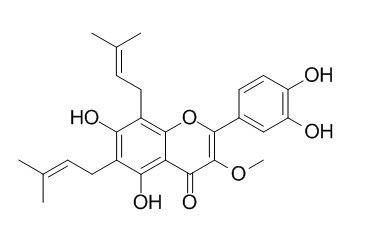Broussoflavonol B
Broussoflavonol B is a potent growth inhibitor of ER-negative breast cancer stem-like cells, may be used to treat breast cancer. Broussoflavonol B increases the growth inhibitory activity of tamoxifen in tumorsphere cells derived from MCF7/TAM cells.
Inquire / Order:
manager@chemfaces.com
Technical Inquiries:
service@chemfaces.com
Tel:
+86-27-84237783
Fax:
+86-27-84254680
Address:
1 Building, No. 83, CheCheng Rd., Wuhan Economic and Technological Development Zone, Wuhan, Hubei 430056, PRC
Providing storage is as stated on the product vial and the vial is kept tightly sealed, the product can be stored for up to
24 months(2-8C).
Wherever possible, you should prepare and use solutions on the same day. However, if you need to make up stock solutions in advance, we recommend that you store the solution as aliquots in tightly sealed vials at -20C. Generally, these will be useable for up to two weeks. Before use, and prior to opening the vial we recommend that you allow your product to equilibrate to room temperature for at least 1 hour.
Need more advice on solubility, usage and handling? Please email to: service@chemfaces.com
The packaging of the product may have turned upside down during transportation, resulting in the natural compounds adhering to the neck or cap of the vial. take the vial out of its packaging and gently shake to let the compounds fall to the bottom of the vial. for liquid products, centrifuge at 200-500 RPM to gather the liquid at the bottom of the vial. try to avoid loss or contamination during handling.
Separations2023, 10(11), 567;
Food Funct.2021, 12(4):1469-1481.
Food and Chemical Toxicology2020, 111221
CZECH MYCOLOGY2021, 73(1):1-19.
J Ethnopharmacol.2018, 210:88-94
Int J Mol Sci.2015, 16(8):18396-411
Korean Journal of Pharmacognosy.2015, 46(4):352-364
Curr Issues Mol Biol.2024, 46(6):6018-6040.
University of Central Lancashire2017, 20472
Eur J Pharmacol.2022, 917:174744.
Related and Featured Products
Eur J Pharmacol. 2013 Aug 15;714(1-3):56-64.
A novel anticancer agent Broussoflavonol B downregulates estrogen receptor (ER)-α36 expression and inhibits growth of ER-negative breast cancer MDA-MB-231 cells.[Pubmed:
23769740]
Estrogen receptor (ER)-negative breast cancers are aggressive and unresponsive to antiestrogens, and current therapeutic modalities for ER-negative breast cancer patients are usually associated with strong toxicity and side effects. Less toxic and more effective targeted therapies are urgently needed to treat this type of breast cancer.
METHODS AND RESULTS:
Here, we report that Broussoflavonol B, a chemical purified from the bark of the Paper Mulberry tree (Broussonetia papyrifera) exhibited potent growth inhibitory activity in ER-negative breast cancer MDA-MB-231 cells at sub-micromolar concentrations. Broussoflavonol B induced cell cycle arrest at both the G₀/G₁ and G₂/M phases accompanied by a downregulation of c-Myc protein, a upregulation of the cell cycle inhibitory proteins p16(INK4a), p19(INK4D) and p21(WAF1/CIP1) and a down-regulation of the expression levels of the G₂/M regulatory proteins such as cyclin B1, cdc2 and cdc25C. Broussoflavonol B also induced apoptotic cell death characterized by accumulation of the annexin V- and propidium iodide-positive cells, and cleavage of caspases 8, 9 and 3. In addition, Broussoflavonol B treatment also decreased the steady state levels of the epidermal growth factor receptor (EGFR) and ER-α36, a variant of estrogen receptor-α, and restricted growth of the stem-like cells in ER-negative breast cancer MDA-MB-231 cells.
CONCLUSIONS:
Our results thus indicate that Broussoflavonol B is a potent growth inhibitor for ER-negative breast cancer cells and provide a rational for preclinical and clinical evaluation of Broussoflavonol B for ER-negative breast cancer therapy.
Am J Cancer Res. 2015 Jan 15;5(2):530-44.
Downregulation of ER-α36 expression sensitizes HER2 overexpressing breast cancer cells to tamoxifen.[Pubmed:
25973295]
Tamoxifen provided a successful treatment for ER-positive breast cancer for many years. However, HER2 overexpressing breast cancer cells respond poorly to tamoxifen therapy presumably by pass. The molecular mechanisms underlying development of tamoxifen resistance have not been well established. Recently, we reported that breast cancer cells with high levels of ER-α36, a variant of ER-α, were resistant to tamoxifen and knockdown of ER-α36 expression in tamoxifen resistant cells with the shRNA method restored tamoxifen sensitivity, indicating that gained ER-α36 expression is one of the underlying mechanisms of tamoxifen resistance.
METHODS AND RESULTS:
Here, we found that tamoxifen induced expression of ER-α36-EGFR/HER2 positive regulatory loops and tamoxifen resistant MCF7 cells (MCF7/TAM) expressed enhanced levels of the loops. Disruption of the ER-α36-EGFR/HER2 positive regulatory loops with the dual tyrosine kinase inhibitor Lapatinib or ER-α36 down-regulator Broussoflavonol B in tamoxifen resistant MCF7 cells restored tamoxifen sensitivity. In addition, we also found both Lapatinib and Broussoflavonol B increased the growth inhibitory activity of tamoxifen in tumorsphere cells derived from MCF7/TAM cells. Our results thus demonstrated that elevated expression of the ER-α36-EGFR/HER2 loops is one of the mechanisms by which ER-positive breast cancer cells escape tamoxifen therapy.
CONCLUSIONS:
Our results thus provided a rational to develop novel therapeutic approaches for tamoxifen resistant patients by targeting the ER-α36-EGFR/HER2 loops.



